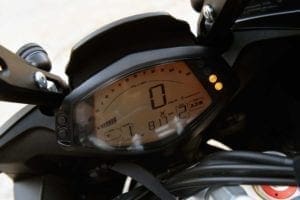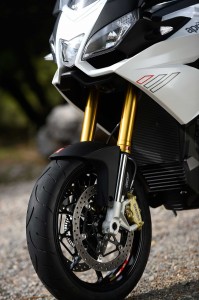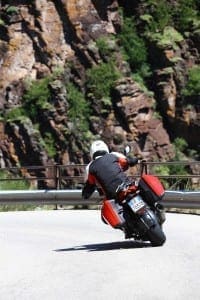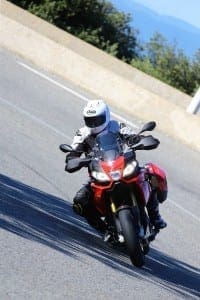£12,934 | 125bhp@8250rpm | 85lb-ft@6800rpm | liquid-cooled 90° V-twin
Tested by Simon Hargreaves Photography by Aprilia
Launched last year, Aprilia’s high-tech Caponord is one of adventure biking’s best-kept secrets, and deserves to be mentioned in the same breath as BMW’s GS and Ducati’s Multistrada. So to remind us what we’re missing, Aprilia invited Motor Cycle Monthly to the south of France to ride the bike again.
Tell me about the engine
 The Caponord uses a retuned version of the Aprilia-designed and built, 1190cc, eight-valve, 90° liquid cooled V-twin that powered their supermoto-styled Dorsoduro 1200 a few years ago. Called the V90 engine (as opposed to the Rotax-built V60 that powered the earlier Mille and Tuono V-twins), the somewhat Ducati-esque longitudinal V makes a claimed 125bhp and 85lb-ft in the Caponord, and features fly-by-wire, three engine modes and three levels of traction control.
The Caponord uses a retuned version of the Aprilia-designed and built, 1190cc, eight-valve, 90° liquid cooled V-twin that powered their supermoto-styled Dorsoduro 1200 a few years ago. Called the V90 engine (as opposed to the Rotax-built V60 that powered the earlier Mille and Tuono V-twins), the somewhat Ducati-esque longitudinal V makes a claimed 125bhp and 85lb-ft in the Caponord, and features fly-by-wire, three engine modes and three levels of traction control.
On paper it’s a rather generic V-twin, featuring all the technology we’d expect: wide bore and short stroke means the engine can safely rev (although with the limiter at 9000rpm it’s not exactly over-stressed), the valve train is driven by a familiar combination of gear and chain, and items like twin-spark plugs, fuel injection, ram-air pressurised air box, and off-set cylinders are all standard issue – it’s not new stuff.
And in moving away from the distinctive 60° cylinder layout, Aprilia has risked losing a unique, identifying feature; no-one else makes a comparable 60° V (Harley’s V-Rod and the Britten racer excepted). A 60° V angle is compact, which allows its weight to be placed close to the front wheel and gives the old Mille’s familiar, inline four-style steering. And the 60° V has a specific vibration feel from its twin-balancer shafts.
 But the new engine benefits from plenty of modern electronic technology. The fly-by-wire throttle eliminates wire cables and allows cruise control to be fitted as standard. Three engine modes – Sport, Touring and Rain – allow either full power with sharpest throttle response, full power with a more gentle throttle response, or a cut-back 90bhp Rain Mode. The Aprilia also has four levels of traction control (including off), determined by wheel acceleration sensor differential, combined with engine revs and throttle position.
But the new engine benefits from plenty of modern electronic technology. The fly-by-wire throttle eliminates wire cables and allows cruise control to be fitted as standard. Three engine modes – Sport, Touring and Rain – allow either full power with sharpest throttle response, full power with a more gentle throttle response, or a cut-back 90bhp Rain Mode. The Aprilia also has four levels of traction control (including off), determined by wheel acceleration sensor differential, combined with engine revs and throttle position.
What’s the chassis like?
The Caponord Travel Pack was, technically, the first ever production bike with semi-active suspension, beating BMW’s HP4 by a matter of days. Like the HP4 (and now R1200GS and S1000R), and Ducati’s Multistrada, the Aprilia uses suspension built by German automotive supplier Sachs. The forks and shock come equipped with servo-motors that continuously vary damping characteristics in a matter of milliseconds.
 How that hardware is deployed in use – what sensors are used, what conditions are actually measured, and the algorithms used to calculate the correct suspension settings – is up to each manufacturer. BMW uses its own software systems; Ducati uses an industry standard algorithm called Skyhook; and Aprilia uses a combination of both. The company says the type of sensors it uses are more accurate than those used by Ducati, and allow for a more accurate setting for the bike.
How that hardware is deployed in use – what sensors are used, what conditions are actually measured, and the algorithms used to calculate the correct suspension settings – is up to each manufacturer. BMW uses its own software systems; Ducati uses an industry standard algorithm called Skyhook; and Aprilia uses a combination of both. The company says the type of sensors it uses are more accurate than those used by Ducati, and allow for a more accurate setting for the bike.
The primary reason for equipping a bike with semi-active suspension is to effectively let the machine determine the best suspension settings for any riding scenario, then give it a set of electronic screwdrivers to adjust the damping continuously on the move. In this way, a soft, plush ride for a motorway can be delivered alongside a firmer, sporty ride for the back roads without the rider having to think about it. Or get on their knees and muck about with a tool-kit.
And the Aprilia goes one step further than its rivals; not only does it remotely, intelligently adjust damping rates, it also adjusts the rear shock preload. Yes, this bike knows how fat you are and how many pairs of underpants are in the panniers, and adjusts the shock to suit.
The rest of the chassis is, like the engine, based on the Dorsoduro 1200. A tube steel top frame is bolted to cast aluminium side plates, with an aluminium alloy swingarm. Brakes are Brembo four-pot radials with switchable ABS.
Should I buy one?
 On paper, you’d be hard pressed to make a case for the Caponord – which is probably one reason why people haven’t been flocking to buy them. It’s not the price; at £12,934 the Aprilia compares with its similarly-specified rivals who are all, give or take, around the £13,000 mark.
On paper, you’d be hard pressed to make a case for the Caponord – which is probably one reason why people haven’t been flocking to buy them. It’s not the price; at £12,934 the Aprilia compares with its similarly-specified rivals who are all, give or take, around the £13,000 mark.
And there might be qualms about Aprilia’s notoriously unreliable spares back-up; Aprilia assure us these issues are a thing of the distant past, and certainly banished since Aprilia’s take-over by the vast Piaggio Group giving access to their resources.
But the real reason the Caponord’s poor sales performance has prompted Aprilia to take the unusual step of relaunching an unchanged bike a year after its initial launch, is because it’s got a brand identity crisis. No matter how good it is to ride or how sophisticated its electronics, no-one has a clear vision of what riding an Aprilia says about them. The rivals are easy: KTM are a bit crazy and hardcore, Triumph are British, BMW are like their cars, Ducati are Italian and passionate. And they’re all cool. And even Honda have got reliability on their side. And Aprilia have… exactly.
And yet you’d be daft to scan all the above and ignore the Aprilia. Because it’s brilliant.
So what’s it like to ride?
 Here’s the thing: the Caponord is hugely fun, very distinctive, immensely capable, very, very clever (maybe a bit too clever) and just about the most comfortable bike this tester has ever ridden.
Here’s the thing: the Caponord is hugely fun, very distinctive, immensely capable, very, very clever (maybe a bit too clever) and just about the most comfortable bike this tester has ever ridden.
The V-twin engine is nothing if not smooth. There’s no lumpity-bumping, no teeth-chattering transmission shudder at low revs, no sense of the motor straining to make a bid for freedom from the frame. Instead it picks up and drives fluently from nothing to the slightly abrupt rev limiter in a long, catapult of civilized drive. In terms of vibration and ease of use, for a V-twin the Caponord has excellent table manners.
And there’s poke on tap too. The claimed 125bhp probably ends up being around 115bhp by the time the excellent gearbox and chain drive have taken their share. And while that’s plenty for an adventure bike – after all, if you need much more that that you’ll also be wanting sportsbike suspension and clip-ons – it’s nowhere near the outputs of BMW’s GS, Triumph’s Explorer, KTM’s 1190 Adventure and Ducati’s Multistrada. In fact the Caponord’s output is closer to Yamaha’s Super Tenere, a bike often criticized for being underpowered.
But the Caponord’s motor is far more peppy than the numbers suggest. In S – for Sports – mode, the bike has its sharpest throttle response and delivers all the slam-dunk overtaking you need to carve up traffic with ease. The fly-by-wire throttle is light, a little jerky if you’re clumsy, but never snatchy. And the subdued thump from the Arrow end-can fitted to our bike (an £800 accessory) turns into a droning howl at full chat. In T-mode, for Touring, the edge is taken off the throttle response but the delivery feels unchanged; in Rain mode, the output is properly modified to around 90bhp.
 Overall, the Caponord’s engine performance isn’t electrifying or over-powering, or even eye-openingly impressive; it’s simply enough for almost every conceivable circumstance, and nicely balanced with the Aprilia’s chassis performance.
Overall, the Caponord’s engine performance isn’t electrifying or over-powering, or even eye-openingly impressive; it’s simply enough for almost every conceivable circumstance, and nicely balanced with the Aprilia’s chassis performance.
And what a performance. The ride quality delivered by Aprilia’s version of semi-active suspension is sublime. Bumps and lumps have the edges smoothed out; the constant, chattering, background noise of thousands of tiny corrugations and imperfections in the road are eased into oblivion. And this isn’t at the expense of feel; there’s enough feedback from the front end to pummel the front tyre into the tarmac on the brakes and still make the corner. There’s never the sense a computer is running the springing show, never the feeling there’s not enough feeling. The Caponord can be slung about with gusto at a level of riding that perfectly matches the engine’s output. Basically, if you’re of a mind, you can get a proper tramp-on with the bike.
And in total comfort. After a 12-hour ride in sweltering Alpine heat, it’s absolutely no word of a lie to say I had no discomfort whatsoever. None. Not a twinge from my bum, not a leg-stretch, not a lift of the arms from the bars. Okay, maybe a hint of finger-ache from the substantial clutch use (those mountain hairpins!). But nothing else. I know comfort is subjective, and the ride didn’t include a great deal of motorway riding (the manually adjustable screen is reasonably effective up or down), but I’ve never, ever ridden a bike for so long without some sort of ache.
So on the rutted, chewed-up Alpine switchbacks of Aprilia’s demanding, 10-hour, 220-mile ride, I can’t think of a quicker, safer, and certainly comfier, bike. If you’re in the market for a new adventure bike, you’d be mad not to get a test ride on a Caponord. Whoever you are.
Tech Spec:
Price: From £12,934
Engine: Liquid-cooled 90° V-twin
Power: 125bhp(92kW)@8250rpm
Torque: 85lb-ft(115Nm)@6800rpm
Weight: 228kg
Seat height: 840mm
Tank size: 17.5litres





